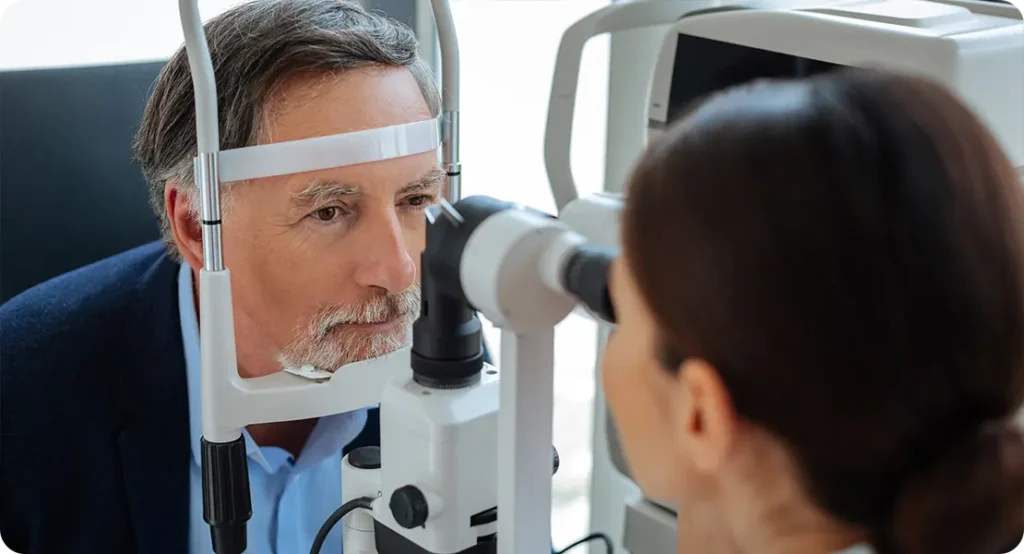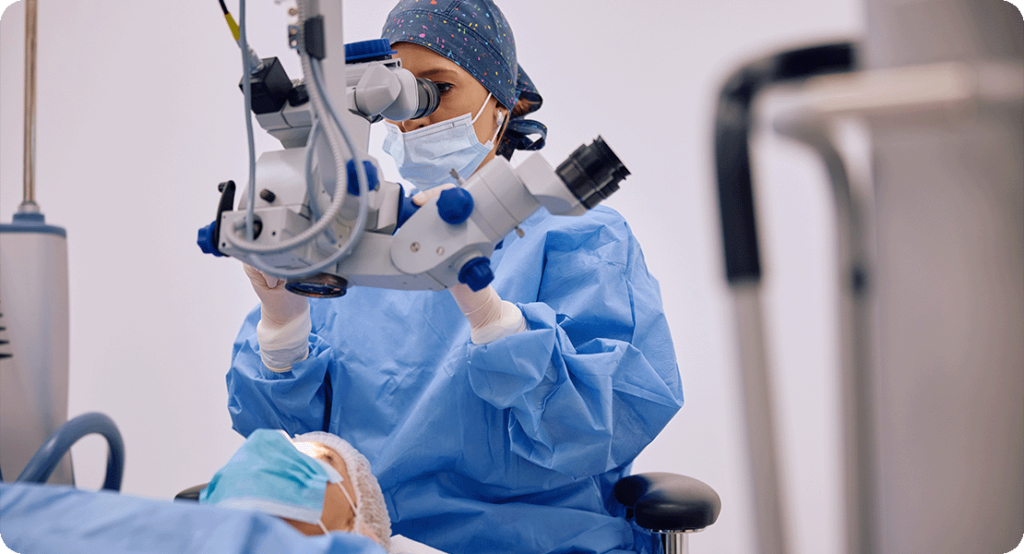Cataracts and glaucoma are two of the most common eye conditions affecting vision, particularly in older adults. While they are distinct conditions, there is a complex relationship between them that can impact diagnosis, treatment, and patient outcomes. Understanding how these conditions interact is essential for effective management and preserving eyesight.
What Are Cataracts?
Cataracts occur when the normally clear lens of the eye becomes cloudy, leading to blurred or impaired vision. This clouding is usually caused by ageing, though factors such as diabetes, prolonged exposure to ultraviolet light, smoking, and certain medications can accelerate their development. Symptoms of cataracts include:
- Blurred or hazy vision
- Vision may gradually become clouded, making it difficult to see fine details. This can interfere with activities such as reading, driving, or recognising faces. The blurring worsens over time, reducing contrast sensitivity and increasing the need for brighter lighting.
- In some cases, the cloudiness can cause double vision or multiple images in one eye, leading to confusion and difficulty in focusing. Patients often find themselves needing frequent changes in their eyeglass prescription as their vision deteriorates.
- Increased sensitivity to light and glare
- Cataracts can cause excessive sensitivity to bright lights, such as sunlight or headlights from oncoming traffic. This can be particularly troublesome while driving at night, making it unsafe for affected individuals.
- Many people with cataracts report seeing halos around lights, which can make navigating low-light environments challenging. Sunglasses and anti-glare coatings on lenses can help alleviate some discomfort, but they do not resolve the underlying issue.
- Difficulty seeing at night
- Night vision is often significantly impaired in cataract patients due to reduced light penetration through the cloudy lens. Dim environments may seem even darker, making it hard to distinguish objects in low light.
- Streetlights and other artificial lights may appear more diffused or scattered, further complicating vision. This can make tasks like night driving or moving around in dark rooms particularly hazardous.
- Fading or yellowing of colours
- Cataracts can cause a yellow or brown tint to develop on the lens, affecting colour perception. Colours may appear duller, and it may become difficult to distinguish between certain shades.
- Over time, this effect intensifies, causing whites to appear more yellow and blues to look more muted. This can affect everyday activities such as matching clothing or appreciating art and nature.
- Frequent changes in prescription glasses
- As cataracts progress, the refractive power of the lens changes, leading to fluctuating vision. Patients often find themselves needing new glasses more frequently than usual.
- However, after a certain point, even the strongest prescription cannot compensate for the cloudy lens, necessitating cataract surgery to restore clarity.

Cataracts typically develop gradually and can be managed with corrective lenses in the early stages. However, as they progress, surgery may be required to replace the cloudy lens with an artificial intraocular lens (IOL), restoring clear vision.
What Is Glaucoma?
Glaucoma is a group of eye diseases that damage the optic nerve, often due to elevated intraocular pressure (IOP). If left untreated, glaucoma can lead to irreversible vision loss. There are several types of glaucoma, but the most common are:
- Primary Open-Angle Glaucoma (POAG):
- This type of glaucoma develops gradually as the drainage canals in the eye become less efficient, leading to a slow increase in eye pressure. Because it progresses silently, vision loss often goes unnoticed until significant damage has occurred.
- As the disease advances, blind spots develop in the peripheral vision. If left untreated, these blind spots merge, leading to tunnel vision and, eventually, total blindness.
- Angle-Closure Glaucoma:
- Unlike POAG, this type occurs suddenly when the iris blocks the eye’s drainage angle, causing a rapid rise in intraocular pressure. It is considered a medical emergency requiring immediate treatment.
- Symptoms include severe eye pain, headaches, nausea, blurred vision, and seeing rainbow-coloured rings around lights. Immediate intervention is necessary to prevent permanent vision loss.
- Normal-Tension Glaucoma:
- In this form of glaucoma, optic nerve damage occurs despite normal eye pressure. Researchers believe that poor blood flow or increased sensitivity of the optic nerve may contribute to this condition.
- Regular eye examinations and imaging tests are crucial for detecting normal-tension glaucoma early, as its progression is often subtle but can still lead to severe vision impairment.
Symptoms of glaucoma, particularly in the early stages, can be subtle, which is why regular eye examinations are crucial. Advanced glaucoma may lead to peripheral vision loss, blind spots, and ultimately blindness.
How Prevalent Is It to Find Cataracts in Glaucoma?
Cataracts and glaucoma often coexist, particularly in ageing populations. Studies have shown that individuals with glaucoma are more likely to develop cataracts over time, mainly due to shared risk factors such as age, diabetes, and long-term use of medications like corticosteroids. While both conditions affect vision in different ways, their prevalence together means that many patients will require a dual management strategy to preserve sight.
The likelihood of cataracts developing in a glaucoma patient increases with the duration of the disease. Since glaucoma is typically managed over many years, the natural ageing process of the eye progresses simultaneously. This means that by the time glaucoma reaches an advanced stage, many patients will have also developed cataracts, compounding their vision difficulties. The presence of both conditions can make diagnosis and treatment more complex, requiring regular monitoring.
Certain types of glaucoma, such as angle-closure glaucoma, may contribute to the early development of cataracts. In angle-closure glaucoma, the narrowing of the drainage angle can cause anatomical changes in the eye, including increased lens thickness. This structural change can accelerate the onset of cataracts compared to individuals without glaucoma. Additionally, intraocular pressure fluctuations associated with glaucoma may contribute to oxidative stress within the eye, further promoting cataract formation.

Given this high prevalence, many ophthalmologists take an integrated approach to managing both conditions. Some patients with glaucoma may undergo cataract surgery not just to restore clarity of vision but also to help reduce intraocular pressure. Modern surgical advancements, such as the combination of cataract extraction with minimally invasive glaucoma surgery (MIGS), have provided new opportunities to treat both conditions simultaneously, improving patient outcomes and quality of life.
What Is the Exact Relationship Between Cataracts and Glaucoma?
Cataracts and glaucoma are two distinct eye conditions, each affecting different structures within the eye. Cataracts impact the eye’s lens, causing it to become cloudy and leading to blurred vision. Glaucoma, on the other hand, is a disease that damages the optic nerve, which is responsible for transmitting visual information from the eye to the brain.
Despite their differences, these two conditions often coexist, particularly in older individuals. While cataracts develop gradually and primarily affect visual clarity, glaucoma is a progressive disease that results in optic nerve damage and vision loss, often without noticeable symptoms in the early stages. This means that while cataracts can be surgically treated to restore vision, vision lost due to glaucoma is irreversible, making early detection and management essential.
One of the key distinctions between the two conditions is how they are treated. Cataracts can be effectively removed through surgery, where the cloudy lens is replaced with a clear artificial intraocular lens. This procedure can significantly improve vision. In contrast, glaucoma requires long-term management, often involving medication or surgery to lower intraocular pressure and prevent further damage to the optic nerve. Unlike cataract treatment, which can restore vision, glaucoma treatments focus solely on slowing disease progression to preserve remaining eyesight.
In some cases, cataract surgery may help glaucoma patients by improving fluid drainage within the eye, thereby reducing intraocular pressure. However, for individuals with advanced glaucoma, surgical intervention must be approached with caution, as fluctuations in eye pressure following surgery could pose additional risks. For this reason, an ophthalmologist may recommend a combined procedure that addresses both conditions simultaneously, ensuring the best possible outcome for the patient.
Managing Cataracts and Glaucoma Together
Because both conditions can impact vision and share treatment considerations, a tailored approach is essential. Key management strategies include:

- Regular Eye Exams:
- Early detection of both cataracts and glaucoma allows for timely intervention, preventing severe vision loss. Routine eye examinations should include intraocular pressure measurements, optic nerve assessments, and visual field tests.
- Advanced imaging techniques such as optical coherence tomography (OCT) help in monitoring subtle changes in the optic nerve and lens structure, aiding in precise treatment planning.
- Careful Monitoring:
- Patients with both conditions should have their intraocular pressure, optic nerve health, and visual function closely monitored. This is particularly crucial for glaucoma patients undergoing cataract surgery, as postoperative pressure fluctuations can be problematic.
- Regular follow-ups ensure that any changes in eye pressure are promptly addressed through medication adjustments or surgical interventions when necessary.
- Personalised Treatment Plans:
- The choice of treatment should consider the severity of each condition. For some, cataract surgery may alleviate glaucoma symptoms, while others may require additional glaucoma-specific procedures.
- Newer surgical options, such as minimally invasive glaucoma surgery (MIGS) performed alongside cataract extraction, offer effective solutions for managing both conditions while minimising risks and recovery time.
- Lifestyle Adjustments:
- Maintaining a healthy diet, exercising regularly, avoiding smoking, and protecting the eyes from UV exposure can help slow disease progression. A diet rich in antioxidants, omega-3 fatty acids, and vitamin C has been linked to better eye health.
- Patients should also be cautious with their head positioning, especially those with advanced glaucoma, as certain activities like yoga poses or heavy lifting can temporarily increase eye pressure.
Can Cataract Surgery Be Undergone by Someone with Glaucoma?
Patients with both cataracts and glaucoma can undergo cataract surgery, but careful planning and specialised management are required. The decision depends on the severity of glaucoma, the stability of intraocular pressure (IOP), and the overall health of the optic nerve. In some cases, cataract surgery can help improve glaucoma symptoms, while in others, additional glaucoma treatment may be necessary alongside the procedure.

Cataract surgery involves removing the cloudy lens and replacing it with an artificial intraocular lens (IOL). For patients with mild to moderate glaucoma, this procedure can enhance vision without significantly impacting eye pressure. However, those with advanced glaucoma may face greater risks, as the procedure can temporarily elevate IOP, potentially worsening optic nerve damage. Therefore, ophthalmologists may recommend a combined surgical approach that addresses both conditions simultaneously.
Some patients may benefit from undergoing a combined procedure, such as cataract surgery with minimally invasive glaucoma surgery (MIGS) or a trabeculectomy. These additional surgical techniques help regulate intraocular pressure during and after the procedure, reducing the risk of pressure spikes. MIGS, in particular, offers a less invasive option that improves drainage and lowers eye pressure while allowing for a quicker recovery compared to traditional glaucoma surgeries.
Postoperative care is critical for patients with both conditions. After cataract surgery, eye pressure fluctuations are common, and glaucoma patients must be closely monitored to prevent sudden spikes that could threaten vision. Medications may need to be adjusted, and follow-up visits with an ophthalmologist will be necessary to track recovery and ensure long-term eye health.
Conclusion
While cataracts and glaucoma are separate eye conditions, they often coexist and influence each other. Understanding their relationship is crucial for early detection, effective treatment, and preserving vision. If you or a loved one are at risk for either condition, scheduling regular eye examinations with an ophthalmologist is the best step towards maintaining eye health and preventing vision loss.
If you are concerned about cataracts and would like a consultation, you can contact the London Cataract Centre for expert advice and treatment options.

